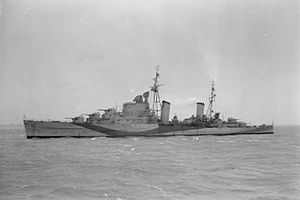HMS Sirius (82)

Sirius leaving Portsmouth, 17 June 1942
|
|
| History | |
|---|---|
|
|
|
| Name: | HMS Sirius |
| Builder: | Portsmouth Dockyard (Portsmouth, UK): Scotts Shipbuilding and Engineering Company (Greenock, Scotland) |
| Laid down: | 6 April 1938 |
| Launched: | 18 September 1940 |
| Commissioned: | 6 May 1942 |
| Decommissioned: | 1949 |
| Out of service: | 14 March 1951 |
| Fate: | Scrapped, Arrived at Blyth yard of Hughes Bolckow, (Northumberland, UK) on 15 October 1956. |
| Notes: | Pennant number 82 |
| General characteristics | |
| Class and type: | Dido-class light cruiser |
| Displacement: |
|
| Length: |
|
| Beam: | 50.5 ft (15.4 m) |
| Draught: | 14 ft (4.3 m) |
| Propulsion: |
|
| Speed: | 32.25 knots (60 km/h) |
| Range: |
|
| Complement: | 480 |
| Armament: |
|
| Armor: |
|
HMS Sirius was a Dido-class light cruiser of the Royal Navy. She was built by Portsmouth Dockyard (Portsmouth, United Kingdom), with the keel being laid down on 6 April 1938. She was launched on 18 September 1940, and commissioned 6 May 1942.
Sirius's completion was delayed due to German bombing at Portsmouth Dockyard. She was completed at Scotts Shipbuilding and Engineering Company (Greenock, Scotland). On completion she initially joined the Home Fleet, and was then assigned to operate in the Mediterranean in August for Operation Pedestal. She was then ordered to the South Atlantic to patrol against Axis blockade runners on the Far East route, returning to Gibraltar in November for Operation Torch, the North African landings. As part of Force Q at Bone in December she harried Axis convoys to and from Tunisia until the Axis surrender in North Africa.
Sirius, as part of Force Q, took part in the last naval battle held in the Mediterranean Sea during 1942. Force Q (Comprising cruisers Sirius, Aurora, Argonaut and destroyers Quentin and Quiberon) intercepted a small Axis convoy in the Sicilian Channel destined for Tunisia, starting the Battle of Skerki Bank. The convoy consisted of the German troopship KT-1 (850 GRT) and Italian troopships Aventino (3,794 GRT), Puccini (2,422 GRT) and Aspromonte (a militarized ferry-boat, 976 GRT) and an escort force composed of three destroyers and two torpedo boats. Force Q intercepted the convoy on the night of 1–2 December. The British ships attacked and sank all four troopships alongside one of the escorting destroyers, heavily damaging another and both torpedo boats. The destroyer Camicia Nera launched all of her six torpedoes from a range of only 2 kilometers but missed the British ships. At dawn, the savage short-range engagement saw a clear British victory: Axis losses amounted to 5 ships and over 2000 men, for the loss of HMS Quentin (G78) at dawn to Luftwaffe bombers.
...
Wikipedia
